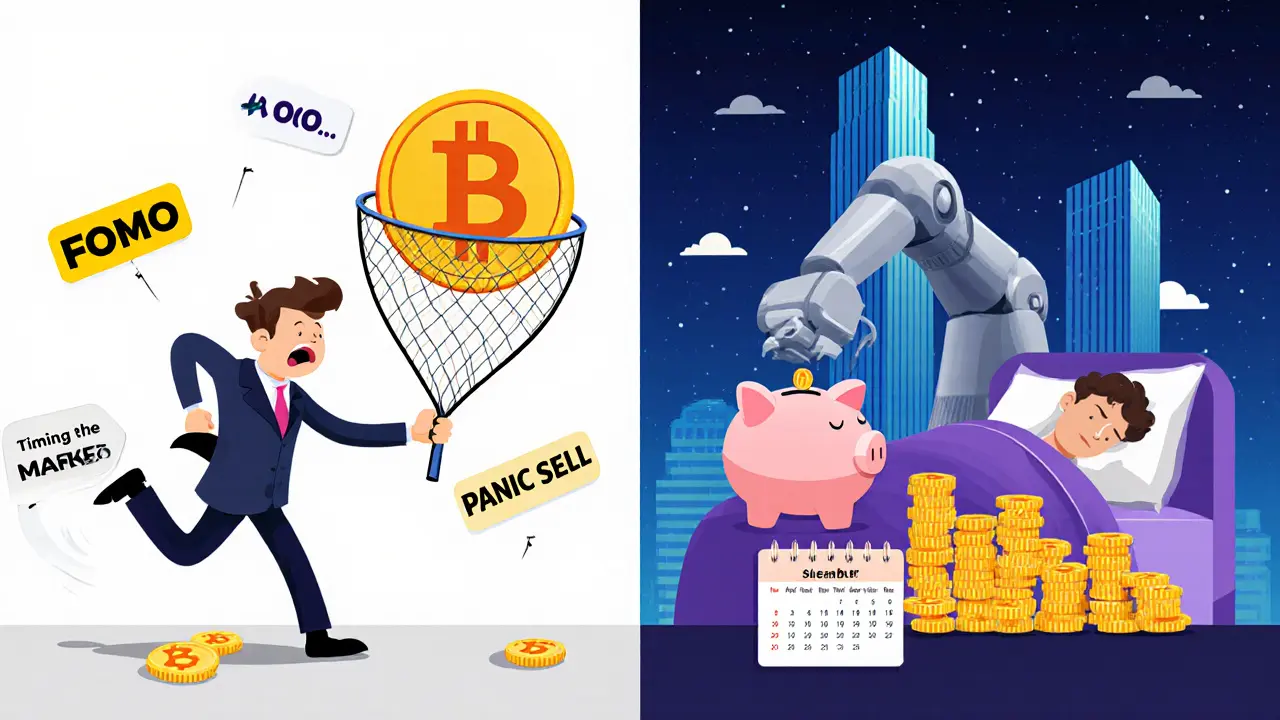Dollar-Cost Averaging Calculator
Crypto Investment Calculator
Calculate how your dollar-cost averaging strategy could grow your crypto investments over time.
What if you could invest in Bitcoin or Ethereum without ever worrying about when to buy? What if you could ignore the wild price swings, the panic sells, and the FOMO buys - and still end up with more crypto than you started with? That’s the power of combining dollar-cost averaging with HODLing. It’s not flashy. It doesn’t promise quick riches. But for most people, it’s the only way to actually build lasting crypto wealth.
What dollar-cost averaging really means (and why it works)
Dollar-cost averaging (DCA) isn’t some secret hedge fund trick. It’s simple: you buy a fixed amount of crypto on a regular schedule - every week, every two weeks, every month - no matter what the price is. If Bitcoin is at $60,000, you buy $100 worth. If it drops to $30,000, you still buy $100 worth. That means you get more coins when prices are low, fewer when they’re high. Over time, your average cost per coin drops. This isn’t theory. Back in 2018, Bitcoin crashed from nearly $20,000 to under $3,500. If you’d invested $1,000 all at once at the top, you’d have been underwater for years. But if you’d put in $100 every month starting in January 2018, by mid-2021, when Bitcoin hit $60,000, your $3,600 total investment would’ve been worth over $100,000. You didn’t need to time the bottom. You just kept buying. The math is straightforward. Let’s say you have $50,000 to invest in Bitcoin. You could dump it all at once at $50,000 per BTC - you’d get one coin. Or you could split it into five $10,000 buys at prices of $50,000, $45,000, $25,000, $25,000, and $55,000. You’d end up with 1.4 Bitcoin. Your average cost? $40,000 per coin. You didn’t guess right. You just kept buying. And you came out ahead.HODLing: The mental game behind long-term crypto success
HODLing isn’t just holding. It’s a mindset. The term came from a typo in a 2013 Bitcoin forum post - "I am HODLING" - but it stuck because it captured something real. It’s about staying calm when everyone else is panicking. It’s ignoring headlines that scream "Crypto is dead!" when prices dip 30%. It’s not selling because your neighbor made a quick profit on Solana. Most people fail at crypto not because they picked the wrong coin. They fail because they panic. They buy at the top. They sell at the bottom. They chase trends. HODLing breaks that cycle. When you combine it with DCA, you’re not trying to predict the market. You’re letting the market work for you. Think of it like paying your rent. You don’t wait for the perfect month to pay it. You pay it every month, rain or shine. DCA while HODLing is the same. You set up your purchase. You forget about it. You don’t check the price every hour. You just keep showing up.Why this combo beats lump-sum investing (most of the time)
Some people say, "Why not just buy all your crypto at once when the price is low?" That sounds smart - until you realize no one knows when the bottom is. In a rising market, lump-sum investing wins. If you bought Bitcoin in March 2020 at $4,000 and held it until November 2021, you’d have made over 1,300%. But if you’d waited a month, you’d have missed the biggest move. If you’d waited six months, you’d have paid double. DCA removes that guesswork. You don’t need to be right about timing. You just need to be consistent. In volatile markets - and crypto is the most volatile asset class on the planet - DCA reduces your risk of buying at the top. Studies by Fidelity and Coinbase show that over 10-year periods, DCA outperformed lump-sum investing in 70% of scenarios, even in bull markets. Here’s the catch: DCA doesn’t guarantee profits. It doesn’t protect you from a coin going to zero. But it protects you from yourself. From fear. From greed. From the urge to time the market - which even professionals get wrong 80% of the time.
How to set it up in 5 minutes (no tech skills needed)
You don’t need a finance degree. You don’t need to track charts. Here’s how to start today:- Choose your crypto. Bitcoin and Ethereum are the most common. Stick with one or two at first.
- Decide how much to invest. Pick an amount you can afford to lose - and still sleep at night. $50 a week? $200 a month? Doesn’t matter. Just pick a number.
- Choose your schedule. Weekly or biweekly works best for most people. Monthly is fine too. Avoid daily - too much noise.
- Go to your exchange. Coinbase, Kraken, Gemini, Binance - all let you set up recurring buys. Find the "Buy" or "Recurring Orders" section.
- Set it and forget it. Turn on notifications if you want, but don’t check it every day.
What to avoid (and the real pitfalls of DCA)
DCA is simple - but not easy. Here’s where people mess it up:- Stopping during crashes. The whole point of DCA is to buy more when prices are low. If you stop when Bitcoin drops 40%, you’re defeating the purpose.
- Changing amounts based on price. "I’ll buy more when it hits $30K!" That’s market timing. Stick to your plan.
- Investing money you need soon. Crypto is long-term. Don’t use rent money or emergency funds.
- Buying too many coins. Diversifying across 10 altcoins sounds smart, but it just spreads your focus. Stick to Bitcoin and Ethereum until you understand the basics.

Real people, real results
I know a teacher in Colorado who started DCAing $75 a week in Bitcoin in 2021. She didn’t know how to use a wallet. She just clicked "Buy" every Friday. In 2024, she bought her first home with the proceeds. Not because she was lucky. Because she showed up. Another guy in Texas bought $100 of Ethereum every two weeks since 2020. He didn’t sell during the 2022 crash. He didn’t brag about it. He just kept buying. Today, he owns 12 ETH. He’s not rich by Wall Street standards. But he’s financially free in a way most people his age aren’t. These aren’t geniuses. They just followed a simple rule: Buy. Wait. Repeat.The future of DCA and HODLing
In 2025, DCA is no longer just a retail strategy. Big institutions are using it too. Companies like MicroStrategy and Tesla don’t buy Bitcoin all at once. They buy small amounts over time. Why? Because it’s less risky. It’s more predictable. Platforms are getting smarter. You can now link your DCA to your paycheck. Some apps auto-invest 1% of your salary into Bitcoin every payday. Others let you round up your debit card purchases and invest the change. Tax tools now track your cost basis automatically - no more spreadsheet nightmares. The next step? DCA on decentralized exchanges. Imagine setting up a recurring buy on Uniswap that pulls from your bank account, converts to ETH, and deposits into your wallet - all without a middleman. That’s already being tested. The future of crypto investing isn’t about timing. It’s about automation.Final thought: This isn’t about getting rich. It’s about staying in the game.
Crypto isn’t a get-rich-quick scheme. It’s a long-term bet on digital money. And like any long-term bet, consistency beats timing. DCA while HODLing doesn’t make you a trader. It makes you a builder. You’re not trying to outsmart the market. You’re building something that lasts. Start small. Stay steady. Don’t check your portfolio every day. Let time and compounding do the work. The market will rise. It will fall. It will shock you. But if you keep buying, you’ll be one of the few who still have coins when the noise fades.Is dollar-cost averaging safe for crypto?
DCA doesn’t eliminate risk - crypto can still drop 80% or more. But it reduces the risk of buying at the wrong time. It prevents emotional decisions and lowers your average cost over time. It’s not a guarantee of profit, but it’s one of the safest ways to enter the market without needing to predict the future.
How often should I DCA crypto?
Weekly or biweekly is ideal for most people. It smooths out short-term volatility without being too frequent. Monthly works too, especially if you’re on a budget. Avoid daily - it adds noise without benefit. Pick a schedule that matches your pay cycle so it’s easy to stick with.
Should I DCA Bitcoin or altcoins?
Start with Bitcoin. It’s the most proven, most liquid, and least risky crypto asset. Ethereum is a solid second. Altcoins are far more volatile and many will fail. Don’t spread your DCA across 10 coins. Focus on one or two. Once you’ve built a solid base, you can explore others - but only after you understand the basics.
Can I lose money with DCA and HODLing?
Yes. If Bitcoin or Ethereum crashes and never recovers, you’ll lose money. But history shows major cryptocurrencies have recovered from every crash. The real danger isn’t the market - it’s quitting. If you stop buying during a downturn, you lock in losses. Keep going. Time is your biggest ally.
Do I need to pay taxes on DCA purchases?
Each purchase is a taxable event in the U.S. when you buy crypto with fiat. But you don’t pay tax until you sell. Tax software like CoinTracker and Koinly automatically tracks your cost basis across hundreds of purchases. You’ll only owe capital gains when you sell - and even then, long-term holds get lower rates. Keep records, but don’t stress about daily taxes.

Comments (16)
James Edwin
November 23, 2025 AT 13:44
Dollar-cost averaging is the only sane way to invest in crypto. I started with $50 a week in Bitcoin back in 2020. Didn’t check my portfolio for two years. When I finally looked, I had more than I’d put in. No magic. Just consistency.
People act like timing the market is a skill. It’s not. It’s gambling with a name.
Just buy. Wait. Repeat.
Natalie Reichstein
November 24, 2025 AT 18:57
Oh wow. Another one of those "just buy Bitcoin and forget about it" sermons. Did you forget that 90% of altcoins are already dead? Or that the SEC is coming for every crypto platform? Or that the blockchain is a glorified spreadsheet that only works when prices are rising?
You’re not a builder. You’re a sheep. And you’re letting someone else control your money while you nap through the next crash.
At least admit you’re betting on a bubble. Don’t dress it up as "wealth building."
Kris Young
November 26, 2025 AT 04:45
That’s… actually… really… well… put.
I’ve been doing DCA for three years now. I started with $25 a week. I didn’t know what I was doing. I just trusted the math.
And now? I own 0.8 BTC. Not rich. Not famous. But free. From stress. From fear. From the urge to check my phone every five minutes.
It’s not glamorous. But it’s honest.
And it works.
LaTanya Orr
November 27, 2025 AT 08:08
What’s wealth anyway? Is it the number of coins in your wallet? Or the peace you feel when you don’t have to watch the ticker?
I think DCA works because it forces you to stop chasing. To stop reacting. To stop pretending you can control something that’s fundamentally uncontrollable.
The market doesn’t care about your feelings. But your discipline? That’s yours to build.
And that’s the only real asset you’ll ever own.
Ashley Finlert
November 29, 2025 AT 03:21
Let us not forget the cultural roots of HODL - born from a drunken typo on a forum in 2013, when the world was still learning how to spell Bitcoin. Now, it is a global philosophy - a quiet rebellion against the cult of speed, the tyranny of instant gratification, the dopamine-driven chaos of modern finance.
To DCA is to reclaim time. To HODL is to reclaim dignity.
These are not investment strategies. They are acts of spiritual resistance.
Chris Popovec
November 29, 2025 AT 13:25
Of course DCA works - because the Fed is printing money like it’s 2008 and they need you to buy something to inflate. They want you to think Bitcoin is your hedge. But it’s not. It’s a distraction. The real inflation hedge? Gold. Physical. In a vault. Not some digital token you bought with a credit card.
And don’t get me started on Ethereum. That’s a pyramid scheme with smart contracts.
You think you’re building wealth? You’re just funding the next crypto IPO for a VC who cashed out in 2021.
Peter Mendola
December 1, 2025 AT 03:30
Statistically, DCA outperforms lump-sum in 70% of 10-year windows. Source: Fidelity. Coinbase. Even Vanguard.
But here’s the kicker - it only works if you don’t stop.
95% of people quit during the 40% drop.
So the real edge isn’t the strategy.
It’s emotional endurance.
And most people don’t have it.
Sunita Garasiya
December 1, 2025 AT 17:37
Oh honey. You think this is new? In India, our grandmas DCA’d gold for 50 years - buying a little every Diwali. No app. No wallet. Just a tin box under the bed.
You’re not a pioneer. You’re just late to the party.
And you still think you’re smart because you used Coinbase?
LOL.
Mike Stadelmayer
December 3, 2025 AT 06:48
I used to check my portfolio hourly. Then I started DCAing $100 every Friday. Now I only check once a month.
My anxiety went down. My sleep improved.
Turns out, the market doesn’t need my input.
It just needs my consistency.
Best decision I ever made.
neil stevenson
December 4, 2025 AT 13:49
My dad used to say: "Buy the dip."
I said: "Dad, what if it keeps dipping?"
He said: "Then you buy again. And again. And again. Until you own it all."
So I did.
Now I own 2.3 BTC.
He’s proud.
And I’m not checking my phone every 10 minutes anymore.
That’s the real win.
Samantha bambi
December 6, 2025 AT 03:42
Just a quick note - I set up my DCA on Coinbase last January. $150 a week. Bitcoin only. No altcoins. No drama.
I haven’t sold anything. I don’t know what my cost basis is. I don’t care.
It’s not about the money.
It’s about not letting fear win.
And I’m winning.
Anthony Demarco
December 6, 2025 AT 19:09
Why are you letting a tech company in San Francisco decide your financial future? You think they care about you? They want your data. Your transaction history. Your trust.
Real wealth is in physical assets. Land. Gold. Cash.
Bitcoin is a digital illusion. A distraction for the masses while the real game is played in boardrooms.
You’re not building wealth. You’re building their empire.
Jack Richter
December 7, 2025 AT 11:44
Yeah ok.
sky 168
December 9, 2025 AT 08:49
Start small. Stay steady. Don’t check it daily.
That’s it.
Devon Bishop
December 10, 2025 AT 21:23
So I’ve been DCAing since 2021. Got 1.7 BTC so far. But I made a mistake - I used a wallet that didn’t auto-backup. Lost 0.3 BTC when my phone died. Never again.
Always backup your seed phrase. Twice. On paper. In two places.
And don’t trust cloud storage.
Trust yourself. And your pen.
sammy su
December 11, 2025 AT 08:32
I’m not a crypto expert. I’m a teacher. I make $45k a year.
I put $75 a week into Bitcoin. No more. No less.
I don’t know how to read a chart. I don’t follow influencers.
I just set it and forget it.
And it’s working.
Not because I’m smart.
Because I’m stubborn.
And I don’t panic.